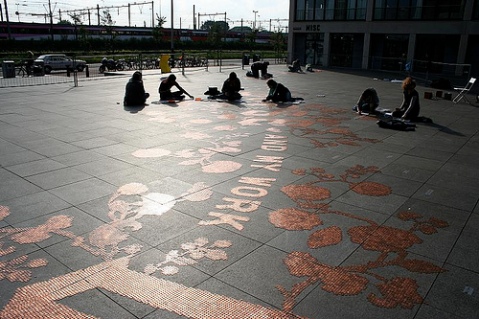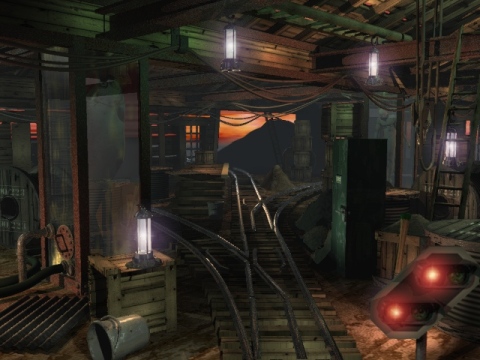Archive for the ‘video games’ Category
MindGym
Hooked up the other day, after a dog’s age, with designmeister Jason Loader (who has just set up on his own as Yeah Love). We made MindGym together way back when – a game about creative thinking. Jason has been kind (and patient) enough over the weekend to dig out some of the old design assets from a moribund machine…
There are some more here
All these 3D environments were designed by Jason Loader (at a time when they typically took over 18 hours to render, so a bit on the frustrating side if you didn’t get it right first time). MindGym was a concept I came up with at Melrose Film Productions in the wake of making a series of films about Creativity. I nicked the title from Lenin or one of those Ruskies, who used the term with reference to chess. So Jason and I started work on it, then the pair of us hooked up with NoHo Digital to realise a bastard creation of great energy. Rob Bevan (now at XPT) did the interface design and programming, skilfully combining this kind of rich 3D with elegant 2D inspired by You Don’t Know Jack. His creative partner Tim Wright led the writing team – him, Ben Miller and me – it was a comic script with serious stuff underlying the gags. I couldn’t help chuckling recently when I heard someone refer to Rob & Tim as the Jagger & Richards of new media. Talking of which, Nigel Harris did the music and sound design – excellent audio was one of our explicit creative goals, again inspired by YDK Jack. And talking of Jack the lads, Paul Canty (now of Preloaded) and Mike Saunders (Kew Digital), who were just starting out, were also among the production team. The studio was infested with red ants (possibly flesh-eating), but it didn’t distract us from the task at hand…
Mashist Groove Thang, or 14 Things I was Inspired by yesterday
Spoke at a really fun event last night – Quickfire organised by Katz Kiely’s Just B (which puts on the bTween interactive media conference every year in Yorkshire). It was a formatted event, Petchakutcha style – 14 slides for 30 seconds each, moving on automatically whether you’re ready or not. There’s something about this kind of format for speaking events which has made the ones I’ve experienced truly inspirational, at the very least very interesting and entertaining – and last night was no exception. I think it’s the combination of concision and parlour game.
Last night’s event was focused on the 13 areas which make up the Creative Industries in governmentspeak. There was one speaker for each area (with just a couple doubled up and with me as Television). The theme across the whole breadth was the impact of connectivity on the discipline in question.
So here are the 14 Things which Inspired me.
1. Advertising – Richard Adams / Chemistry
Not the Watership Down Richard Adams but an imposter who knows a lot about the way brands need to approach interactive media. I liked the term he used – “Mecast” – to capture the shift from broadcasting to active engagement with creative material (including advertising).
2. Architecture – Armand Terulli & Ghislaine Boddington / Body Data Space
I was taken with the glass roof they’d designed for a school in Kingston(?), London which detects light changes and alters the opacity accordingly – not in a uniform way but in a digitally designed pattern to cast a natural feeling pattern of shadows which looked like leaves in sunshine.
3/4. Television & Radio – Yours truly / Channel 4
I really got a buzz from the challenge of speaking in conjunction with an out-of-(my)-control automated set of images (as is my wont with Powerpoint, I only used pictures, no words). It appealed in its semi-improvised nature to the wannabe jazzer in me.
5/6. Art & Antiques – Fiddian Warman / Soda
Fiddian showed off the breadth of Soda’s work across pretty much all of the 13 sub-sectors (he struggled by his own admission with Fashion and had to make do with the sweat-shirts they sell bearing their designs). The huge Energy Ring in the Science Museum (which I haven’t yet seen in real-life) was impressive, as was the digital light display on the side of a tower in a North London school (Stoke Newington?) – I had no idea they had done this kind of work. I’m more familiar with the likes of the Irrepressible project they did for Amnesty which is one of the most purposeful mash-ups I’ve come across).
7. Computer Games – Charles Cecil / Revolution
Charming Charles, decendent of Robert of Elizabethan fame, gave a fantastic overview of the Games industry in a mere 840 seconds. I liked the look of Broken Sword 1 which I’ve never played but reminded me of retro bandes-desinees like Yves Chaland. Pictures of Charles’ juvenalia from the era of the ZX Spectrum were particularly inspirational – the man’s been living Games for a long time now.
8. Crafts – James Boardwell / Rattle
The interface between digital technology and crafts I know nothing about so this was a great (global) trip. One image showed craft creations inspired by some Manga-style PlayStation game ranging from ear muffs to a pink cake! You gotta love it.
There were some convincing reflections on the contrast between the speed of the digital age and the slowness of Craft – there’s no doubt we can all use some Slow Time. I’ve noticed that a significant proportion of people who leave the new media industry go off to do stuff like horticulture and carpentry.
9. Design – Kristina Nyzell / Lego
This one just reminded me of happy hours playing Lego in my room in Selvage Lane – although apparently “it’s not a toy” – brands, dontcha just love ’em?
10. Film – Matt Hanson / Swarm of Angels
An interesting attempt to create a user-generated feature film based on subscriptions from participants. Apparently though “there has to be a head chef in the kitchen and that’s me!” Can’t beat benign dictatorship to get stuff done. Reminds me of the scene in Channel 4’s documentary about Findhorn a couple of years ago where the hippies were trying to design a leaflet collectively – never happened til the designer took the law in his own hands. Swarm makes an interesting comparison with the current MyMovieMashup project from FilmFour, MySpace and Vertigo Films. Also with Michaela Ledwidge’s Sanctuary project at Mod Films. So my inspiration here was the memory of the last movie I watched, last weekend, Walk on Water which was a good entertaining and moving film made in pretty much the normal way without that much cash.
11. Music – Martyn Ware / Illustrious
Who’d have thought when I went in to buy that 7″ of Fascist Groove Thang all those years ago that one day I’d be sharing a stage with the cuddly Martyn Ware, founder member of the Human League, Heaven 17er, and unflagging champion of interactive audio. We used to do the BAFTA Interactive Entertainment committee together when we were young&foolish. He gave me the low-down on that Bruce Nauman sonic installation at Tate Modern – sounds like it was pretty much the audio equivalent of Jeff Koons, most of it made (very badly in Martyn’s ears) by the hired help. You can catch Mr Ware on his Future of Sound tour on 12th April out East at Queen Mary, University of London. Hoping to include some of his work as the first example of sonic public art in my Big Art Mob mobile blogging project launching next month. [test design above]
12. Performing Arts – Kelli Dipple / Tate
This speaker didn’t play the game because she had had to step into the breach at the eleventh hour – there was no synchronisation between words and pictures. So the pleasure in this one lay in the energy of the performance, which was as it should be for the subject.
13. Publishing – Mike Butcher / Mbites
Mike gave a quickfire history of publishing from an aboriginal cave painting via the Gutenberg bible and sufragette pamphleteering (which he likened to this very act of blogging) to Marconi and Logie Baird, to whom I suppose I owe more than the occasional admiring reflection as I walk past the John Baird public house. I enjoyed the link to the lost art of pamphleteering and will think further on it.
And my fourteenth inspiration to round off? The enjoyment of analogue connectivity in a big room with wine and cake. The room where I first came across Alfie Dennen, setting off the chain of connection which has resulted in the Big Art Mob. The room where I talked acoustics with Martyn Ware (including of the Whispering Gallery in Saint Paul’s where I proposed) and where I talked swing bands with Katz who is paying me for the gig in music.
Creative Accounting
A gathering last night of the UK Creative Industries Forum chaired by Barry Shearman MP. Was sat next to Shaun Woodward, the Minister for the Creative Industries, who gave us an update on the Creative Economy Programme and the unfolding process around the Green Paper. One useful thing that should come out of the programme are better stats around the Creative Industries which account for some 8% of the UK economy yet lack the basic metrics of sectors like the Financial Services. Whilst our sector has been growing consistently at a healthy 6% p.a. it is something of a wayward youth in terms of its lack of hard data and immature industry representation to government. The analysis forming the first part of the Green Paper stems from the rationale that “you can’t manage what you can’t measure”. That of course raises the question of whether it’s about Management or Facilitation.
The skills and education issues were prominent as ever. The Minister drew the attention of the Video Games industry, represented by Ian Livingstone of Eidos, that unlike the perfect distribution and vital statistics of Lara Croft, there are only four industry-accredited games courses in the UK of which three are in Scotland, none in England.
What struck me again during the conversation was just what a balancing act the coining of the term ‘Creative Industries’ set off. Whilst the Creative Economy Programme is trying to identify the common principles and dynamics of the 13 industries under this umbrella, the conversation brought out the significant distinctions and variations of perspective between Music (as represented by Andy Heath of Beggars Group) and Theatre (as championed by Stephanie Sirr, boss of Nottingham Playhouse), between Design (David Worthington, formerly of Conran) and Architecture. Attitudes towards the development of IPR and community experience, by way of examples, were a far cry from what’s happening in the land where TV meets Interactive Media that I inhabit.
 Comments (7)
Comments (7)

















